Performance in guru-devotee identity in Hinduism
Guest post by Dhruv Ramnath
I am a Sai Baba devotee questioning devotional identity.[1] I met Prema Sai Baba[2]—the third reincarnation of the 19th century guru Sai Baba—on 29 July 2007 in his Bengaluru ashram. It was raining. I was drenched under a shamiana (an Indian marquee). When I went for darshan He told me three things. First, give happiness to your parents. Second, give happiness to others. Third, spread My message like ‘a little Swamiji’. I refrain from a hagiographical-cum-autobiographical discussion on personalism and glorification—which I am very good at—as it would convert you. Unlike Maya Warrier (d. 2021), I do not apostrophise divinity.[3] Instead, I venture into academic experiences to make sense of devotional identity post-Sathya Sai Baba’s death in the context of spirituality, India, culture, anthropology and the Internet within a double-bind of creativity and reflexivity, the latter of which is enmeshed in a discursive tangle where privilege (a middle-class Brahmin) and power (writing for an estimable blog) acknowledge guilt (is there an ‘innocent discourse’?). I too am power.
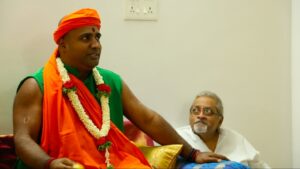 Prema Sai (aka Sharavana Baba) with former Sovietologist Ramnath Narayanswamy (the author’s father). Courtesy Dhruv Ramnath.
Prema Sai (aka Sharavana Baba) with former Sovietologist Ramnath Narayanswamy (the author’s father). Courtesy Dhruv Ramnath.
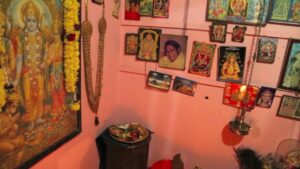 Pictures inside Prema Sai’s family’s shrine in Sreekrishnapuram, Kerala, south India, in 2017. Courtesy Dhruv Ramnath.
Pictures inside Prema Sai’s family’s shrine in Sreekrishnapuram, Kerala, south India, in 2017. Courtesy Dhruv Ramnath.
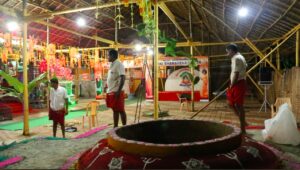 Notice the background with Shirdi Sai Baba, Prema Sai Baba and Sathya Sai Baba. Courtesy Dhruv Ramnath.
Notice the background with Shirdi Sai Baba, Prema Sai Baba and Sathya Sai Baba. Courtesy Dhruv Ramnath.
Nobody talks of Shirdi Sai’s death. We say samadhi (holy tomb) to connote where His body is buried. I capitalise my pronouns to signify devotion biblically. ‘He’, ‘She’ and ‘It’ justify the spectacular creation of God as Guru. Why not Goddess, you ask? ‘Her’ feminist articulation, bound to linguistic boundaries situated like identity on Instagram (she/her), is key when fixing Western historical understandings of knowledge in modern Indian thought, although Vedanta asks, Who am I? The concerns are legitimate: we need to know why ‘it’ has ever been ‘man’, not ‘woman’. However, if we were to debate this, we may end up questioning language rather than devotional identity as transcendental with demonic, human and angelic features. I am alluding to the instability of devotion online (devotees claiming to be devotees of Gurus but not practising godly teachings in reality) and anti-devotion offline (communists and left-wing intellectuals who support democratic freedom but who resist Hindu guru activity due to concerns about Hindutva). To boot, the cross-disciplinary nature of pronoun formation in gender studies, coupled with a socio-political lens through which devotion is problematised, lead to a new discovery: the body is gender while the soul is genderless. Shirdi Sai’s death in 1918 marks the moment in Sai Baba history when the body leaves while the soul stays, leaving behind a question: Was he a Muslim or Hindu?
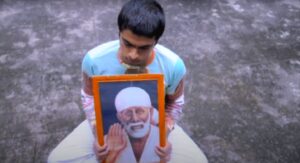 From the author’s film where he depicts an allegorical Shirdi Sai
From the author’s film where he depicts an allegorical Shirdi Sai
Next, what is identity? In my fieldwork with the Prema Sai movement I notice shifting changes in devotional identity. Not all who claim to be ‘devotees’ are fixated on Sai Baba in the sense with which the media highlight the ‘devotee’ (a devotee is known by the guru he keeps) and the ‘guru’ (not all gurus are genuine but those who are will inevitably be fraudulent as the nature of guru-faith is borne from the superstitiousness of Marx’s ‘oppressed creature’ and like the Sikhs, since some guru groups “do good work”, they are OK). That there can be a genuine Sai Baba is compounded by mediated discourse and the internal politics of ‘guru versus Guru’ in the Kali Yuga[4] cinched by caste, class and gender creations of an already existing divided Indian society gone global and which seeks plurality with the rise—or fall—of Modi. Prema Sai’s claim to Prema Sai status humbly (“I am not Muruga”), and the secret revelation of His divinity to chosen ones, evokes Amma’s declaration that a Guru is an example of identity in reverse: ‘From Amma’s Heart’, page 29: ‘No Claims’
‘From Amma’s Heart’, page 29: ‘No Claims’
Then, I ask: What are the political implications of guru identity? Amma attending a meet of the Hindu right-wing outfit called the RSS[5] is juxtaposed with Hindu Vivek Kendra’s publication of an Indian Express article calling Sathya Sai a “godman”—whose meaning is replete with complexity—followed by south Indian politician Karunanidhi’s espousal of Baba’s teachings. Between these webs of net spillage lie the anthropologist’s patient refusal to identify as a devotee due to critical distancing (social distancing was not introduced pre-Covid). Maya Warrier, Amanda Lucia, Lawrence Babb and Tulasi Srinivas have contributed astounding scholarship to the field, yet their virtual disbelief or creative obfuscation of identifying as devotees is interesting; Smriti Srinivas too writes from distance—not devotion. Hence I key in in the start: I am a Sai Baba devotee questioning devotional identity as ‘I’ am in the suspension of disbelief while explicating how social groups tethered to faith’s scrum compete and contest for “proxemic desire” (Srinivas 2010). Srinivas’ term denotes the push for being physically close to Sai Baba as a competitive play between devotees. Here is the paradox: Shashi Tharoor’s mother is a Sathya Sai devotee, when Congressman Rashmikant says (see 29:10), “I got this ring from Sai Baba but I am a follower not because of this” and when T.M. Krishna sings for Sathya Sai; however if Taslima Nasreen wonders why Tharoor tweets about Amma,
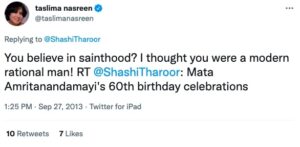 I wonder why I do not.
I wonder why I do not.
Last comes ‘rationality’ and ‘faith’, a binary logic which has overshadowed academic perspectives in the media due to scandal, sex, death and pelf caught in films portraying these with legitimate deliberation and concern for all types of people—the layman, sceptic, rationalist, anti-guru activist, atheist, terrorist and worldly, rendering the spiritual as an object of investigation that makes the guru literally omnipresent—on our screens he appears Machiavellian. Osho, Nithyananda, Jaggi Vasudev, Gurmeet Singh and Sri Sri have presented themselves as gurus talking to Gurus. Osho said Sathya Sai was “a fraud, and… has chosen the name Satya Sai Baba to deceive people that he is the reincarnation of Sai Baba”; Nithyananda is pooh-poohed by right-winger Rajiv Malhotra though my namesake does not get the joke that Rajiv is making; Jaggi Vasudev charges money to teach meditation as his followers cry (see 1:46); Gurmeet Singh is a rockstar beyond the pale of fraudulence; and Sri Sri, whom Shobhaa De (whose daughter Radhika De is a Sri Sri bhakt) called ‘the bearded lady’, had said Prema Sai will be born in 2017 post-Sathya Sai’s death. Such is the way in which gurus are depicted in the media—they become tendentious places from where identity is imposed with an array of texts sabotaging God.
The transmissibility of charisma and debates on who is God and who is not are as equally delicious to analyse as the people who flock to holy/unholy zones to work out their karmas. More fascinating than the bhava (emotion) of Bharatanatyam is Devi’s image in Sai Baba and Amma’s representation. Gender is constructed sacredly. Sexuality is disconnected from spirituality in this scheme of things: gender forms a blest backdrop to invoke the inner as an abstract realm detached from bodily identity to bolster godly remembrance. I thus see Jan Kounen’s remarkable documentary ‘Darshan’ as an act of remembering, an offering of the arts at the threshold of such images.
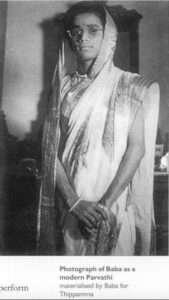
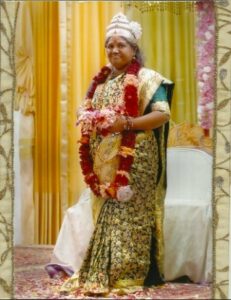 Picture of Sai Baba courtesy here; Picture of Amma courtesy here
Picture of Sai Baba courtesy here; Picture of Amma courtesy here
A public site of contestation is the nature of the media today. Ditto with my article’s methods. Are emails public or private? What about WhatsApp messages? Anyone can publish an image and bastardise it. A fool can create fake social media accounts. None know the truth as it eludes even the devout (as they seek self-revelation they themselves know they are on the illusory journey of worldly life) who act in locales to further hidden agendas and tendencies dormant in the human mind (petty and major politics play out in ashrams). A perusal of Prema Sai’s Facebook page shows how bhakti appears in the modern world in this context. Now, if you google Prema Sai, you will find a gamut of information interspersed with its concomitant interpretations; you will ask who is Prema Sai? He is an unannounced enigma; ‘His’ hagiography sanctioned by institutions may lead to controversy in Sai Baba culture (in a conflictual state presently). Goddess Raja Rajeshwari Amma sarcastically calls Madhusudan, a man claiming godhood, a “divine personality”. Sly Baba?
To me devotional identity is underscored by anonymity. Nomenclature is produced by lexicons that are produced by people who end up with “bullshit jobs” (Graeber 2018). So is the guru phenomenon (a catchy term culled from the media) and their devotees. No guru is the same like no devotee is the same; they are unfixed and mobile entities ascribing value to intangible spheres of identity depending on time, place and circumstance. “I am a Sai Baba devotee questioning devotional identity” is a ruse to avoid falling into an abyss of identification. I am guilty of concealing the enigma where language ends for I am caught in the cycle of birth and death. Poor me!
On 29 July 2007 I met Murali Krishna Swami. Shirdi Sai was dead; Sathya Sai was alive. Did it matter? In 2009 His name changed to Sharavana Baba. On 18 January 2022, I note the progress of not only my habits of mind but also the habits of academe that have changed from the seeker to the anthropologist to the anthropologist and seeker. Having been aware that devotees are speaking in and through academe, I confess the ambiguity with which I opine. I therefore do not know the real Prema Sai as I do not know who I am. That’s the rub. As I type these words, I recall Maya Warrier, a scholar whom I never met but whose work compelled me to think critically as our two Skype conversations and email exchanges led me to believe in the necessity of secular knowledge. As a wimpy filmmaker, I dream of more interdisciplinary scholarship (currently hanging under a cloud). This is for her.
Dhruv Ramnath graduated with a Master’s degree in Social Anthropology at the School of Oriental and African Studies in London.
Bibliography
Babb, Lawrence. 1986. Redemptive Encounters: Three Modern Styles in the Hindu Tradition. Berkeley and Los Angeles: University of California Press.
Graeber, David. 2018. Bullshit Jobs: A Theory. New York: Simon & Schuster.
Lucia, Amanda. 2014. Reflections of Amma: Devotees in a Global Embrace. Berkeley and Los Angeles: University of California Press.
Srinivas, Smriti. 2008. In the Presence of Sai Baba: Body, City, and Memory in a Global Religious Movement. Leiden and Boston: Brill.
Srinivas, Tulasi. 2010. Winged Faith: Rethinking Globalization and Religious Pluralism Through the Sathya Sai Movement. New York: Columbia University Press.
Warrier, Maya. 2005. Hindu Selves in a Modern World. London and New York: Routledge Curzon.
Notes
[1] Gayatri Spivak once said she is intellectually insecure. I admit to the same. I fear my objectivity as a student may be squashed by advertently positioning myself as a representative of the self-realised Prema Sai Baba. This cowardly act of accepting complicity while exploring from a non-dual lens explains my lies and truths. It is like Priyanka Chopra speaking against racism in America after Modi attends her wedding reception in India, but I say like = like and social media creates such two-sided sides. Also, while talking of guilt it seems to me that the holier-than-thou scholar’s hypocrisy needs questioning as much as devotional identity does. I am referring to the so-called controversy surrounding Saiba Verma’s book on Kashmir. Funnily, Saiba and Sai Babas share similarities—both are part of institutions riven with politics. The claim to non-partisanship undercuts our work as intellectuals if we do not accept the truth that power is an example of itself. Think of Pradip Krishen, Arundhati Roy’s husband, who will be paid to landscape the new Parliament building in New Delhi. He was once opposed to the Central Vista Project and now he is benefitting from it!
[2] There are three Sai Babas in Indian guru tradition. The first was Shirdi Sai Baba, the second was Sathya Sai Baba and the third is Prema Sai Baba. Prema Sai literature is sparse.
[3]Warrier inserted apostrophes whenever explaining the Indian female saint Mata Amritanandamayi’s divine status. In her book Hindu Selves in a Modern World she apostrophised words like divine, surrender and experience, not explaining why she purported not to accept wholeheartedly the devotees’ claim of these states to which she as an anthropologist was unattached and simply ‘observing’ (see page 29).
[4] In Hinduism, there are four epochs in human history, the last is Kali Yuga. In 1968, Sathya Sai said it would last 5320 years and can be known as “the age of quarrels [and] pollution”. See here.
[5] Rashtriya Swayamsevak Sangh